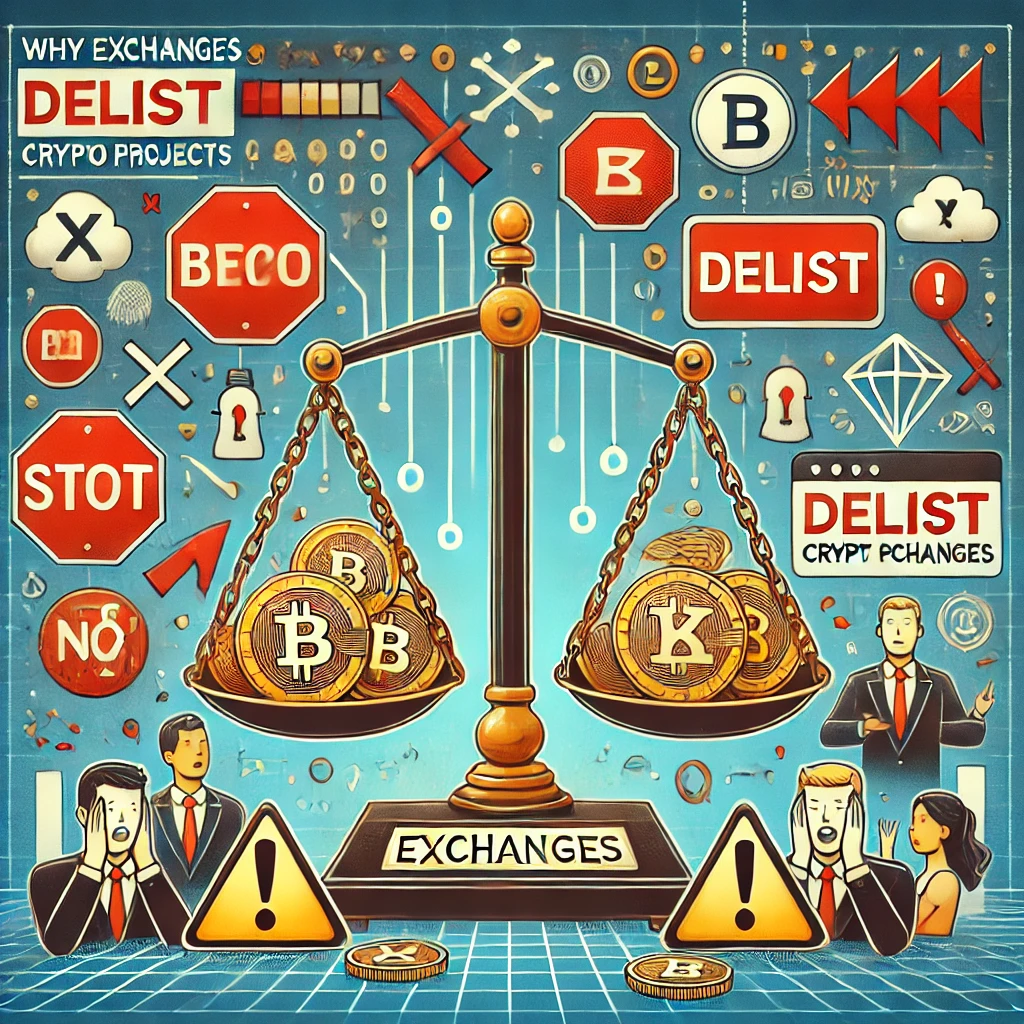Table of Contents
Introduction
Cryptocurrency exchanges serve as the lifeblood of the digital asset ecosystem, providing a platform for trading and liquidity. However, the listing and delisting of crypto projects have significant implications for the market, project teams, and investors. While listing is often seen as a milestone for projects, delisting can be an equally pivotal moment, sometimes signaling deeper issues. This article explores why exchanges delist crypto projects, the impact on investors, and how individuals can safeguard their investments in a volatile market.
What Is Delisting?
Delisting refers to the removal of a cryptocurrency from an exchange’s trading platform. This can happen temporarily or permanently, depending on the reasons and circumstances. Temporary delistings often arise from technical issues, while permanent delistings typically indicate more severe concerns such as regulatory violations or project abandonment.
Exchanges have a fiduciary responsibility to maintain the integrity of their platforms, which includes removing projects that may pose risks to their users. Delisting decisions are guided by internal policies, regulatory compliance, and the overall performance of a token in the market.
Common Reasons for Delisting Crypto Projects
Regulatory Non-Compliance
Cryptocurrencies operate in a fragmented regulatory landscape, with varying requirements across jurisdictions. Projects that fail to comply with Anti-Money Laundering (AML) or Know Your Customer (KYC) policies, or those flagged for regulatory violations, are prime candidates for delisting.
Example: Ripple’s XRP faced delisting on several exchanges following the U.S. SEC’s lawsuit, alleging it was an unregistered security.
Fraudulent or Misleading Practices
Crypto projects that engage in scams, rug pulls, or deceptive marketing are frequently removed to protect users and the exchange’s reputation. Exchanges often monitor projects post-listing and take action if they detect unethical practices.
Example: Numerous tokens have been delisted after being exposed as pump-and-dump schemes.
Lack of Trading Volume
Trading volume is a critical metric for exchanges. Tokens with insufficient liquidity generate minimal fees and may create challenges for maintaining market stability. Low trading activity is a strong indicator that a project has lost investor interest.
Example: Many low-cap altcoins face delisting due to a lack of sustained demand.
Technical or Security Issues
Technical vulnerabilities, such as buggy smart contracts or security breaches, can lead to delisting. Exchanges prioritize safety and will not hesitate to remove tokens that expose users to risks.
Example: Projects with unresolved exploits often find themselves blacklisted from major platforms.
Project Abandonment or Failure
A lack of developer activity, missed roadmap milestones, and dwindling community engagement are red flags. Exchanges monitor the lifecycle of projects and delist those deemed defunct or abandoned.
Example: Dead projects, where developers have ceased operations, are regularly removed to clear market clutter.
The Impact on Investors
Immediate Financial Implications
Delistings often lead to sharp price drops due to reduced liquidity and market accessibility. Investors holding the token may find it challenging to sell or convert their holdings, resulting in potential losses.
Example: Tokens delisted from major exchanges frequently experience a significant decline in value, sometimes as high as 90%.
Psychological Impact
Delisting erodes trust in both the project and the exchange. Investors may feel betrayed, particularly if the delisting comes without adequate notice or explanation. This psychological toll can deter future investments.
Long-Term Consequences
After delisting, accessing tokens becomes cumbersome, often requiring the use of less secure or decentralized platforms. Investors may also lose faith in the broader market, affecting sentiment and participation.
How Exchanges Handle the Delisting Process
Notification to Investors
Reputable exchanges prioritize transparency by issuing public announcements about delistings, including timelines for withdrawal. This ensures investors have adequate time to act.
Providing Timelines for Withdrawals
Exchanges typically provide a grace period for users to withdraw delisted tokens. Failure to withdraw within the stipulated time can result in loss of funds.
Technical Considerations for Token Removal
The delisting process involves technical steps to disable trading pairs, wallets, and APIs associated with the token. Exchanges also ensure security during this process.
Legal and Compliance Measures
Delisting often includes consultation with legal and compliance teams to ensure the decision aligns with regulatory frameworks and minimizes liability.
How Investors Can Protect Themselves
Research and Due Diligence
Investors should thoroughly investigate a project’s whitepaper, team credentials, and roadmap before investing. A proactive approach helps identify red flags early.
Portfolio Diversification
Holding a variety of assets minimizes the impact of a single token being delisted. Diversification reduces exposure to individual project risks.
Monitoring Exchange Announcements
Staying updated with exchange notifications and regulatory news is essential. Proactive investors can make informed decisions in response to potential delistings.
Leveraging Decentralized Options
Decentralized exchanges (DEXs) offer alternative avenues for trading delisted tokens. Platforms like Uniswap or PancakeSwap provide liquidity for many tokens that have been removed from centralized exchanges.
The Broader Implications of Delisting for the Crypto Ecosystem
Impact on Project Credibility
Delisting tarnishes a project’s reputation, signaling potential issues to existing and prospective investors. Projects must address the reasons for delisting to rebuild trust.
Exchanges’ Role in Shaping Market Standards
By delisting non-compliant or underperforming tokens, exchanges set a precedent for quality and accountability. This improves overall market health.
Encouraging Accountability Among Crypto Projects
Delisting acts as a wake-up call for projects to prioritize transparency, governance, and community engagement. It highlights the need for long-term planning and adherence to regulatory standards.
Delisting is an inevitable part of the evolving cryptocurrency ecosystem. While it often signals issues with specific projects, it also reflects the maturing standards of exchanges. Investors must remain vigilant, diversifying their portfolios and staying informed about developments. For the crypto ecosystem, delistings underline the importance of accountability, transparency, and long-term vision. As the market continues to grow, striking a balance between inclusivity and integrity will remain a central challenge for exchanges.










